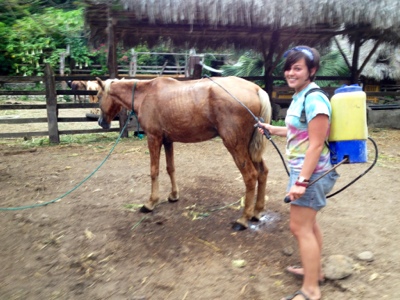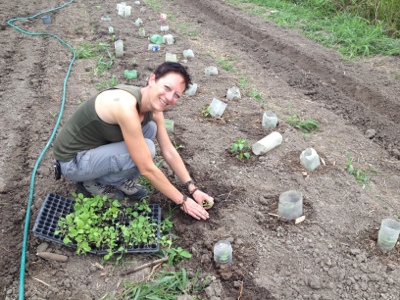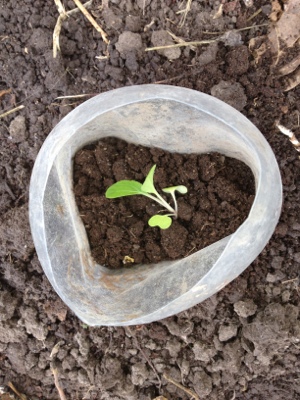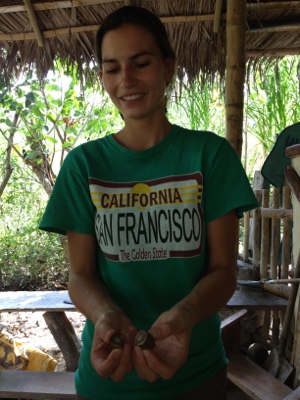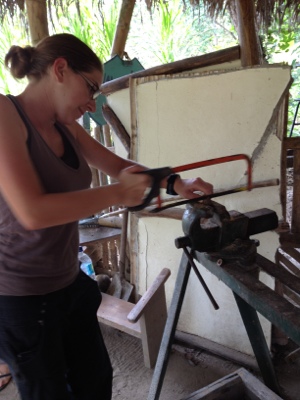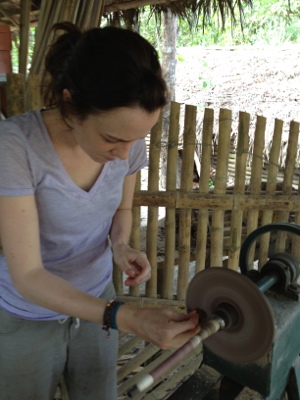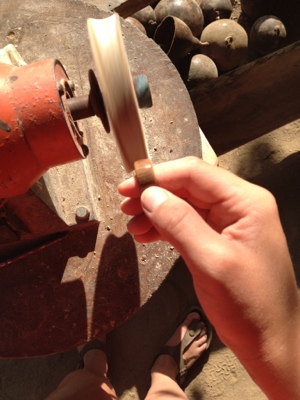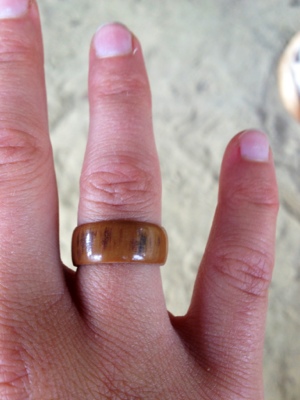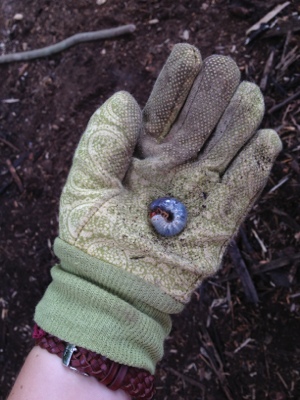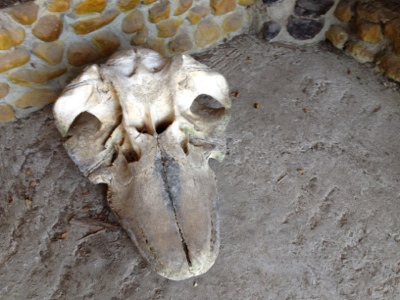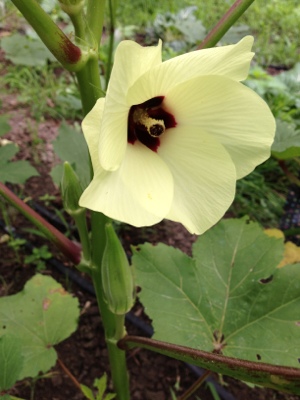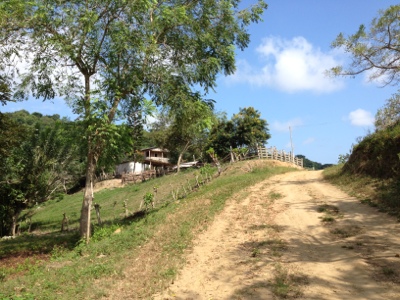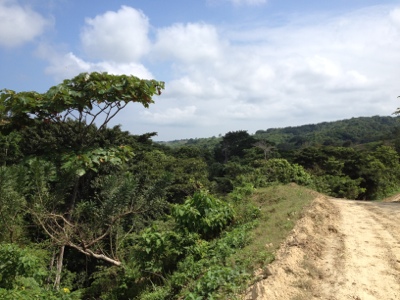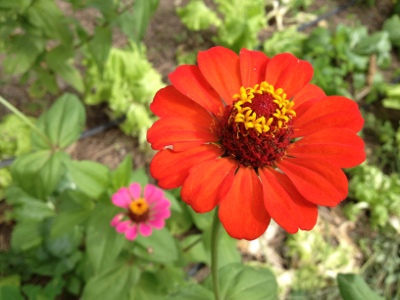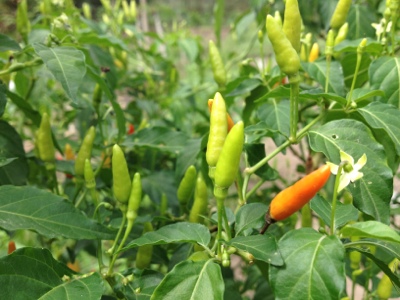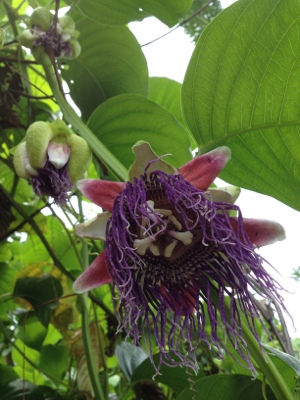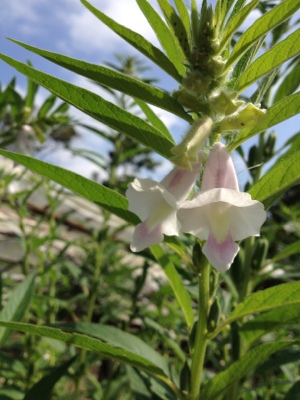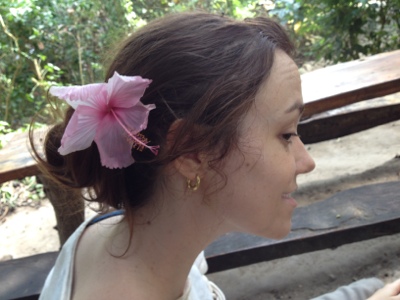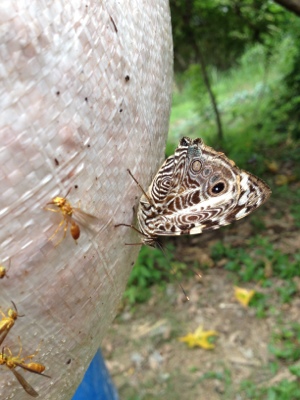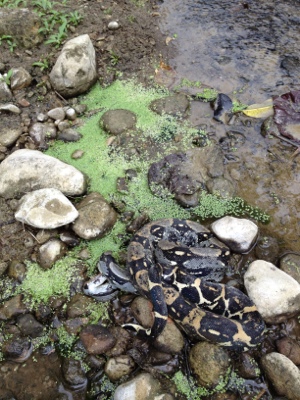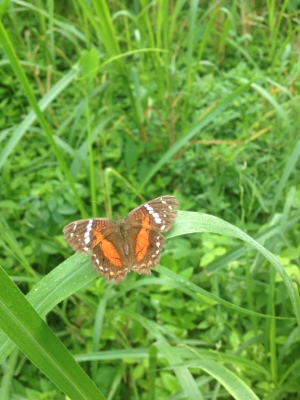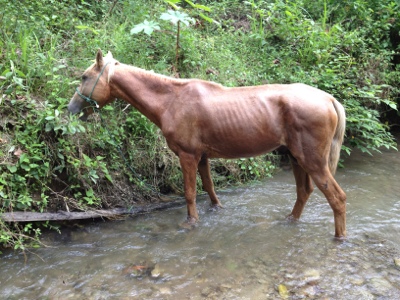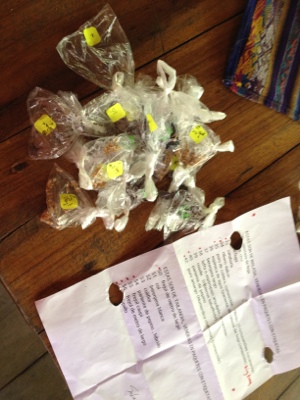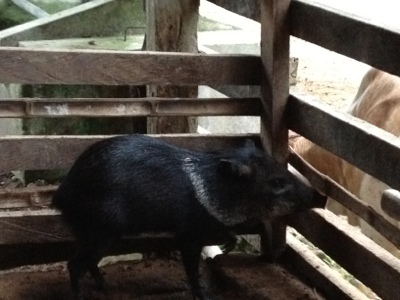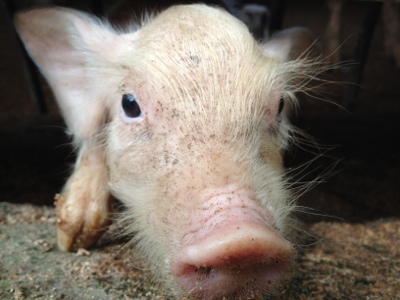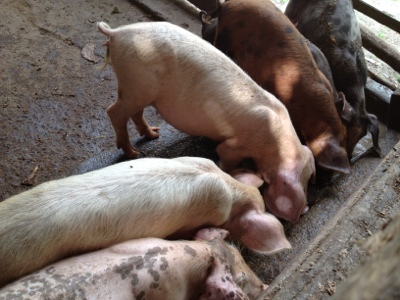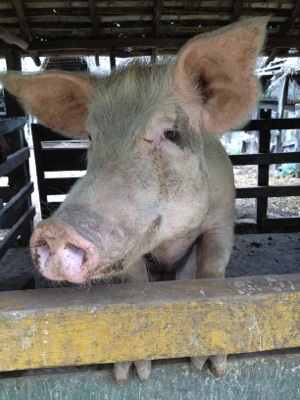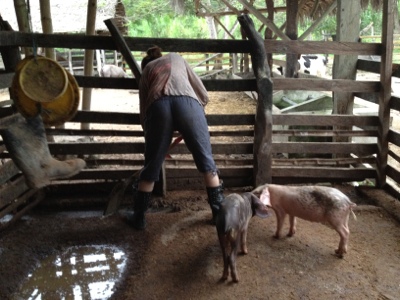I have met an incredible number and variety of people over the last three weeks. They have really helped define my experience here, so I would like to give you a glimpse into the world of characters in which I have been functioning.
Dario and Nicola are the couple who owns and runs the farm. Dario is Ecuadorian, originally from Quito, and is 60 years old. Nicola is originally from New Zealand, but she has been going back and forth between there and Ecuador for the past 25-ish years. She is 49. The two met around 1990 and have been together, un-married ever since. They just had twins, Rafael and Florence, seven months ago. They live together as a family in the main house of the farm, which is also the location of the kitchen and community space, my shared bedroom and other bedrooms, and the office. Nicola runs the garden and Dario deals with the animals and the tourism side of the farm. They have many businesses together. The farm, which includes the actual farming and ecotourism; the school down the street, which they started for the community and continue to oversee; and Ecopapel, which is a paper recycling company that makes handmade papers, which was started by Nicola and employs about ten people full time. They are totally busy are overworked, especially since the arrival of the twins, who are currently teething and chronically unhappy.
Julia is the ecotourism intern who has been here for ten months. She is from Germany, and is taking a gap year between high school and college. She works in the Canoa office once per week, and she schedules and oversees all tourists and groups that come through the farm. She also doubles as nanny and does many other small tasks around the house–she is on call at all times, and is usually exhausted. She plans to study sports management when she returns to Germany in September.

Kevin smiling pretty
Kevin is the volunteer coordinator intern who is on his fourth of seven months here. He is from Philadelphia and is in his mid-thirties. He quit his full time volunteer coordinator job to come here and take a vacation, gain experience, and learn the language. He is an accomplished yogi, and I have enjoyed practicing with him in the Sai Baba Garden.
There are a handful of individuals from the community who work at the farm full time. First is Norita, who is a light in a sometimes tense house. She is the head cook, and she must be in her seventies. She is so sweet and cute. She really takes care of everyone on the farm. Her eight-year-old great-granddaughter, Cristel, lives with her and calls her Mami.
Dexi is Norita’s sous chef. she doesn’t work every single day, but she is here most of the time. She provides a foil to Norita’s cherry demeanor. She can be a bit snippy, but is quite funny if you can break through to her good side.
There are five guys who make everything on the farm happen. Leo is Norita’s grandson, and I honestly don’t know him very well because we never work together. Roberto is a man of few and mumbled words who works in the garden. Sergio lives across the street and is the in-house carpenter and fix it man. He has worked for the farm since the beginning. Danilo and Oscar are the two guys I spend the most time with and therefore know the best. Danilo is 24 and has three kids. He works with the animals and in the garden. He desperately wants to learn English because it would make his job so much easier. He attends colegio (essentially high school) in another town in the weekends. He is a huge joker, and I can actually understand his jokes because he speaks slowly and clearly enough for the volunteers to understand. Oscar is 28 and has no kids, and he has worked here for 11 years. He deals with the horses and works in the garden. He helps me with Rory, and he has taught me many Spanish words recently through our conversations while we take the horses to pasture.
Melina is the oldest daughter of Sergio. She is eighteen and she has a two-year-old child. She lives across the street with her family, but she spends all day at the main house of the farm taking care of the twins. Her little daughter, Jeni, gets left with Sergio’s wife as Melina helps raise Nicola’s children. She is very talented at painting designs on toe an fingernails.
Moving on to the volunteers who have really made my experience wonderful thus far…
T amara was my first friend on the farm. She is 23 years old and from Toronto, but her family migrated from Georgia/Russia when she was twelve. Her first language is Russian. She studied Environmental Science at the University of Guelph and worked at her university’s Office of Sustainability. She then worked for a year as her school’s recycling coordinator. She came to Ecuador this summer for a vacation before she heads off to Newfoundland to start her masters in the recycling of electronics around the world. She was in Ecuador for a total of two months. She started at a farm in the mountains near Otavalo, but after some management problems started she decided to move. She came to Rio Muchacho two weeks before I did, and stayed for two more weeks after I arrived. We became fast friends as we weeded beds of beets my first morning and discovered that we have an incredible number of things in common. Our personalities and dispositions are very similar, we have similar health challenges, and we both use yoga as a way to deal with the world. She is blunt and funny and very self-aware, and we had so much fun together talking and laughing and sharing stories and histories. It was so hard to say goodbye last Sunday, but we made an agreement to visit each other this coming year with Catherine.
amara was my first friend on the farm. She is 23 years old and from Toronto, but her family migrated from Georgia/Russia when she was twelve. Her first language is Russian. She studied Environmental Science at the University of Guelph and worked at her university’s Office of Sustainability. She then worked for a year as her school’s recycling coordinator. She came to Ecuador this summer for a vacation before she heads off to Newfoundland to start her masters in the recycling of electronics around the world. She was in Ecuador for a total of two months. She started at a farm in the mountains near Otavalo, but after some management problems started she decided to move. She came to Rio Muchacho two weeks before I did, and stayed for two more weeks after I arrived. We became fast friends as we weeded beds of beets my first morning and discovered that we have an incredible number of things in common. Our personalities and dispositions are very similar, we have similar health challenges, and we both use yoga as a way to deal with the world. She is blunt and funny and very self-aware, and we had so much fun together talking and laughing and sharing stories and histories. It was so hard to say goodbye last Sunday, but we made an agreement to visit each other this coming year with Catherine.
Catherine was the third girl in our trio. She arrived the day after I did, and we soon found that our personalities worked perfectly together with Tamara’s. Catherine is 24 years old and from Montreal. Her first languag e is French. She did International Studies for her undergrad and is going into her second year of a Social Work masters degree. She came to Ecuador and Rio Muchacho to regroup after a difficult year and to improve her Spanish. She will be on the farm for approximately six weeks total, after which she will travel around Ecuador for a bit longer. She has done an incredible amount of traveling over the past ten years. She has been to Cuba, Burkina Faso in Africa, 13 countries in Asia over nine months last year, and now Ecuador. Catherine came across as shy when I first met her, but her true sense of humor and witty, intelligent banter came through quickly. When Tamara left, Catherine moved her belongings to the bed next to mine. Now we are able to lay in bed and talk or sit on our beds and practice our instruments–guitar for her and mandolin for me–both of which have happened a lot this past week. She will be here for at least as long as I will, so I will have one good friend for the rest of my stay on the farm, and into the future.
e is French. She did International Studies for her undergrad and is going into her second year of a Social Work masters degree. She came to Ecuador and Rio Muchacho to regroup after a difficult year and to improve her Spanish. She will be on the farm for approximately six weeks total, after which she will travel around Ecuador for a bit longer. She has done an incredible amount of traveling over the past ten years. She has been to Cuba, Burkina Faso in Africa, 13 countries in Asia over nine months last year, and now Ecuador. Catherine came across as shy when I first met her, but her true sense of humor and witty, intelligent banter came through quickly. When Tamara left, Catherine moved her belongings to the bed next to mine. Now we are able to lay in bed and talk or sit on our beds and practice our instruments–guitar for her and mandolin for me–both of which have happened a lot this past week. She will be here for at least as long as I will, so I will have one good friend for the rest of my stay on the farm, and into the future.
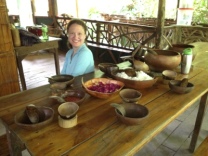
Amy at the lunch table
Amy and Yvan (pronounced Ivan) are a married couple who have been together for 17 years. They arrived at the farm three days after me, and they stayed until Thursday of this week. They are on a ten-week trip through Ecuador, Peru, and Lima. Their next stop is Lima to visit a close friend and her family. Amy and Yvan were only here for two weeks, but their presence made a huge impact on both the farm and the school. They are both teachers. Amy teaches Spanish and Yvan is a history teacher who is currently working as a sub. Amy is fluent in Spanish, and she is also a creative writer of both novels and plays. She has the air of an actress and the heart of a mother, though she is not one. Yvan is sweet to the core, and is incredibly humble, kind, and generous. They had just completed their TEFL training this spring, and they came prepared to jump right in at the Escuela Ambientalista Río Muchacho. They spent most of their time there, teaching English and creative thinking through songs, games, and activities. They were adored by students and teachers alike, and Amy ended up putting on a workshop for eighteen teachers from nearby schools to teach them how to teach their students how to be creative thinkers in the classroom. In Ecuador, math is emphasized over most other subjects, so this is a fairly radical concept for them to grasp. It was sad to say goodbye, but I now have a standing invitation to visit them in Seattle.
We have seen many other people pass through…there was a Swiss family who stayed here for three days. They were at the tail end of a five month trip around Ecuador with their eight and eleven-year-old girl and boy, respectively. They were an interesting bunch and I enjoyed hearing about their experiences in a Quechua community in the rainforest and at the Galapagos. We had a woman named Mia who is from Finland but living in Australia. We have seen a group of 50 college students from Quito, another of 10 students from all over the world, and a third of 15 highschoolers from the States, all at the same time. We also received two volunteers at the beginning of this week: Karen from New Zealand and Maren from Germany. I was in bed for the first two days of the week and have just started getting to know them, so I’ll report back in a week or two about my new roommates.
That’s everyone for now, but I’m sure there will be more people to come.
